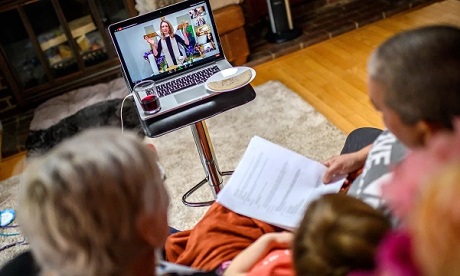Online services are hitting the spot with about a quarter of Americans, a Pew Research Centre poll has found.
The November 2022 survey of over 11,000 US adults focused on how many were engaging in online worship and how they felt about the experience.
Post-pandemic, the online option is still a popular choice. While most find it satisfactory, they said they prefer an in-person experience at church.
Many said they felt less connected to other worshippers when online.
Connection with others
About two-thirds of regular in-person churchgoers said that they felt “quite a bit” or “a great deal” of connection with others attending the same service.
In contrast, just over a quarter (28 percent) of regular virtual viewers reported the same sense of connection with in-person worshippers when they watch online or on TV.
Fifty-one percent of people who attend online services said they generally watched the services alone; most don’t join in the singing or praying when they watched online.
They usually do when they attend in person, they said.
Convenience is key
Most online worshippers told Pew they prefer the online services because they are convenient rather than for reasons of personal safety.
There are ethnic differences at play with that finding, however. Pew says Black congregation members were more likely to join online services – owing partly to continuing concerns about Covid, which has disproportionately affected Black communities.
Seventeen per cent continued to join online and in person. Most said they were satisfied with online services.
“Broadly speaking, the survey finds that most Americans who watch religious services on screens are happy with them.
“Two-thirds of US adults who regularly stream religious services online or watch them on TV say they are either ‘extremely satisfied’ or ‘very satisfied’ with the services they see,” the researchers say.
Interestingly, those who both watched services online and attended church in person were more likely to follow virtual services from a different church from the one they usually attended.
Sermons and music
About two thirds of respondents said they were satisfied with the sermons they hear during virtual services. In addition, just over half reported being highly satisfied with the music at worship services they join online or watch on TV.
In comparison, those attending services in person seem to be getting more out of the experience. Seventy-four percent say they feel extremely or very satisfied with the sermons; 69 percent say they are satisfied with the music.
Religious technology
The survey also asked about “religious technology”, such as prayer or Bible apps.
Members of historically Black Protestant churches (37 per cent), as well as Evangelical Protestants (28 per cent), were the most likely to engage at least weekly in technology for religious purposes.
They use apps for prayer or scripture and participating in online study groups.
Key findings show:
30 percent of US adults say they go online to search for information about religion.
21 percent use apps or websites to help them read the Bible or other religious scriptures.
15 percent listen to religion-focused podcasts.
14 percent use apps or websites to help or remind them to pray.
Source
Additional readingNews category: World.




